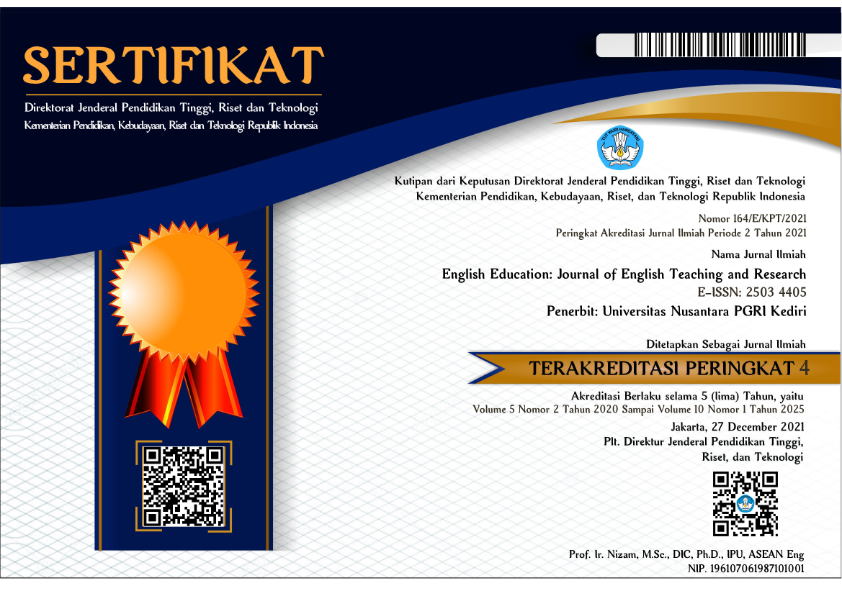English Teachers’ Innovative Approach to Teaching Speaking Skills
DOI:
https://doi.org/10.29407/jetar.v10i2.24216Keywords:
English language teaching, Innovative Approach, Speaking skills, English language teaching, innovative approach, : Group Investigation; Speaking skill learning; AnxietyAbstract
To facilitate students with speaking proficiency that is applicable in today’s real-world communication, an innovative approach to teaching of speaking is needed. The purpose of this research is to investigate what innovative teaching approach that teachers use to teach students English speaking skills that will assist them in real-world communication. This study used a qualitative-descriptive case study design. The data were collected through observations and interviews and analyzed by using thematic analysis. The findings reveal that there are six characteristics of innovative teaching that teachers used when teaching English speaking skills in the classroom. They are teacher-student collaboration, HOTS oriented towards the teaching of speaking, integration of ICT in the teaching of speaking, teaching of speaking that involve 21st-century learning skills, teaching of speaking that strengthen literacy skills, and the teaching of speaking that strengthen character education (SCE). Understanding the innovative teaching of speaking implemented by the teacher as revealed in this study, further studies intended to analyze and deepen the understanding of the impact of these innovative teaching approach on students’ speaking performance should be conducted.
Downloads
References
Anburaj, G., Christopher, G., & Ming, N. (2014). Innovative methods of teaching English language. IOSR Journal of Humanities and Social Science, 19(8), 62-65. https://www.iosrjournals.org/iosr-jhss/papers/Vol19-issue8/Version-4/M019846265.pdf
Aqnia, N. F., Ariani, M. & Rofiq, A. (2024). Identifying English teachers' emotional labour while teaching speaking in the EFL class: A narrative inquiry. EFL Education Journal, 11(1), 69-87. https://jurnal.unej.ac.id/index.php/EFLEJ
Asiyah, S., Wiyono, B. B., Hidayah, N., & Supriyanto, A. (2021). The effect of professional development, innovative work, and work commitment on the quality of teacher learning in elementary schools of Indonesia. Eurasian Journal of Educational Research, 95, 227-246. https://doi.org/10.14689/ejer.2021.95.13
Bahrani, T., & Soltani, R. (2012). How to teach speaking skill. Journal of Education and Practice, 3(2), 25-29. https://www.iiste.org/Journals/index.php/JEP/article/view/1147/1068
Bizami, N. A., Tasir, Z., & Na, K. S. (2023). Innovative pedagogical principles and technological tools capabilities for immersive blended learning: A systematic literature review. Education and Information Technologies, 28(2), 1373-1425. https://doi.org/10.1007/s10639-022-11243-w
Braun, V., & Clarke, V. (2006). Using thematic analysis in psychology. Qualitative Research In Psychology, 3(2), 77-101. https://doi.org/10.1191/1478088706qp063oa
Budirahayu, T., & Saud, M. (2023). Pedagogical innovation and teacher collaborations in supporting student learning success in Indonesia. Cogent Education, 10(2), 1-16. https://doi.org/10.1080/2331186X.2023.2271713
Bulturbayevich, M. B., Rahmat, A., &Murrodullayevich, M. N. (2021). Improving teacher-students collaboration and educational effectiveness by overcoming learning challenges. AKSARA: JurnalIlmu Pendidikan Nonformal, 7(1), 153-159. https://doi.org/10.37905/aksara.7.1.153-160.2021
Collins, R. (2014). Skills for the 21st century: Teaching higher-order thinking. Curriculum & Leadership Journal, 12(14). https://www.semanticscholar.org/paper/Skills-for-the-21st-Century%3A-teaching-higher-order-Collins/1f694d4b9e977e5ca3026c72796603a3bf8f3197
Coombe, C., Reinders, H., Littlejohn, A., &Tafazoli, D. (2019). Innovation in language learning and teaching: The case of MENA. In: Reinders, H., Coombe, C., Littlejohn, A., Tafazoli, D. (eds). Innovation in Language Learning and Teaching. New Language Learning and Teaching Environments.London: Palgrave Macmillan.https://doi.org/10.1007/978-3-030-13413-6_1
Darasawang, P., Reinders, H., & Waters, A. (2015). Innovation in language learning and teaching: The case of Thailand. London: Palgrave Macmillan.
Fraser, S. (2019). Understanding innovative teaching practice in higher education: A framework for reflection. Higher Education Research & Development, 38(7), 1-15. https://doi.org/10.1080/07294360.2019.1654439
Istiharoh, M. &Indartono, S. (2020). Learning innovation for character education in global era: Methods and assessments. Education and Humanities Research, 323, 272-279. https://doi.org/10.2991/icossce-icsmc-18.2019.50
Kementerian Pendidikan dan Kebudayaan. (2018). Permendikbud no 20 tahun 2018 tentangpenguatanpendidikankarakter pada satuanpendidikan formal di Indonesia. Jakarta: Kementerian Pendidikan dan Kebudayaan.
Maysaroh, A., Fitriyah, S. M., &Suharjito, B. (2022). Indonesian teachers' perceptions of students' problems and the possible causes when speaking English in the EFL classroom. EFL Education Journal, 9(1), 151-168. https://jurnal.unej.ac.id/index.php/EFLEJ
Miyarso, E. (2019). Perancanganpembelajaraninovatif. Aceh: Universitas Bina BangsaGetsempena.
Othman, M., Sahamid, H., Zulkefli, M. H., Hashim, R., & Mohamad, F. (2015). The effects of debate competition on critical thinking among Malaysians second language learners. Middle-East Journal of Scientific Research, 23(4), 656-664. https://doi.org/10.5829/idosi.mejsr.2015.23.04.22001
Putu, I., Suhardiana, I. P. A., & Lestari, N. L. G. W. (2020). Enhancing students' literacy skills through the use of English storybooks. Yavana Bhāshā: Journal of English Language Education, 3(1), 80-87. https://doi.org/10.25078/YB.V1I1.1380
Rao, P. (2019). The importance of speaking skills in English classroom. Alford Council of International English & Literature Journal (ACIELJ), 2(2), 6-18. https://www.researchgate.net/publication/334283040
Uyun, A. (2022). Teaching English speaking strategies. Journal of English Language Learning (JELL), 6(1), 14-23. https://doi.org/10.31949/jell.v6i1.2475
Widiastuti, I. A. M. S., Murtini, N. M. W., & Anto, R. (2022). Brainstorming as an effective learning strategy to promote students’ critical thinking skills. Jurnal Pendidikan Progresif, 12(2), 960-971. https://doi.org/10.23960/jpp.v12.i2.202243
Yamin, M., & Purwati, O. (2021). Enhancing innovative pedagogy in teaching English as an international language for Indonesian learners. English Teaching Journal: A Journal of English Literature, Linguistics, and Education,9(2), 101-113. https://doi.org/10.11591/etj.v9i2.10117
Yin, R. K. (2018). Case study research and applications, design and methods (6th ed.). Thousand Oaks, CA: Sage Publications.
Yuzyk, O. P., Vysochan, L. M., &Grytsyk, N. V. (2019). Innovative teaching methods in higher education institutions of Poland and Ukraine. Scientific Journals of Higher Technical School in Katowice, 11, 45-50. https://scholar.google.pt/citations?view_op=view_citation&hl=en&user=EXv-u3cAAAAJ&citation_for_view=EXv-u3cAAAAJ:7PzlFSSx8tAC
Downloads
Published
Issue
Section
License
Copyright (c) 2025 Nandita Fitriani, Annur Rofiq, Musli Ariani

This work is licensed under a Creative Commons Attribution-ShareAlike 4.0 International License.
Authors who publish with this journal agree to the following terms:
- Copyright on any article is retained by the author(s).
- The author grants the journal, the right of first publication with the work simultaneously licensed under a Creative Commons Attribution License that allows others to share the work with an acknowledgment of the work’s authorship and initial publication in this journal.
- Authors are able to enter into separate, additional contractual arrangements for the non-exclusive distribution of the journal’s published version of the work (e.g., post it to an institutional repository or publish it in a book), with an acknowledgment of its initial publication in this journal.
- Authors are permitted and encouraged to post their work online (e.g., in institutional repositories or on their website) prior to and during the submission process, as it can lead to productive exchanges, as well as earlier and greater citation of published work.
- The article and any associated published material is distributed under the Creative Commons Attribution-ShareAlike 4.0 International License








 Article template
Article template



